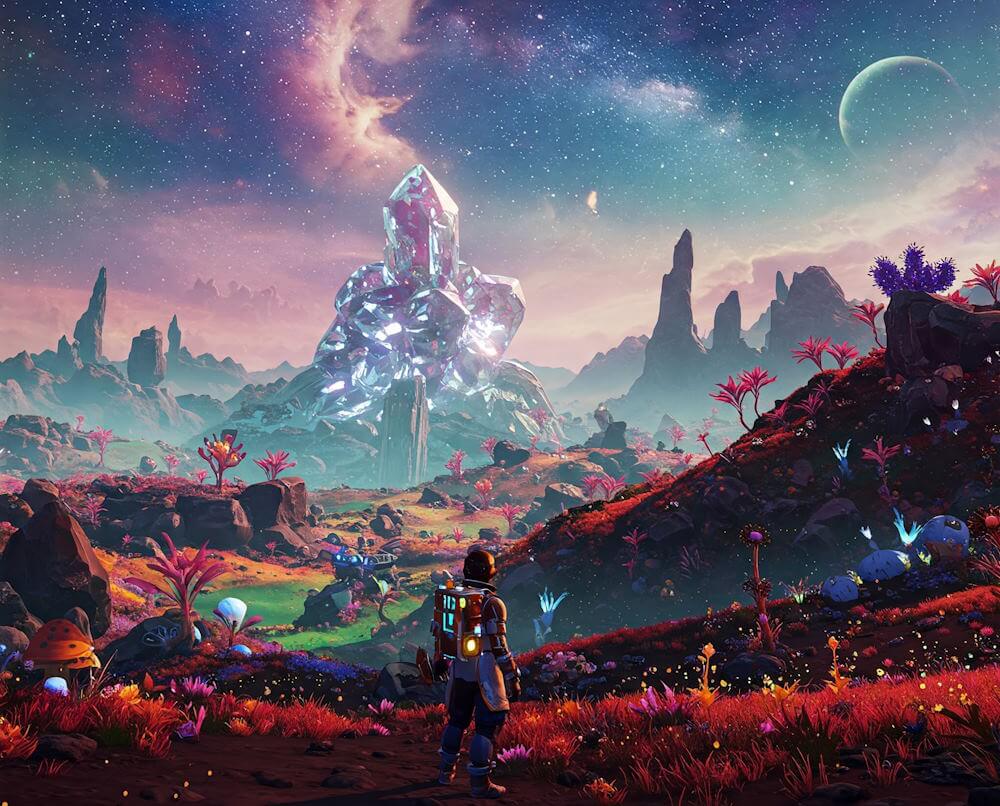No Man’s Sky is a science fiction exploration game developed by the indie studio Hello Games, initially launched in August 2016. The game was heavily marketed prior to its release, boasting ambitious features such as an infinite universe, fully procedurally generated planets, and a plethora of diverse ecosystems. Players were promised the opportunity to explore vast expanses of space, discover unique flora and fauna, and build bases across the countless worlds that populate the game’s universe. Such lofty expectations created a significant amount of hype within the gaming community.
Upon its release, however, No Man’s Sky faced considerable backlash due to a perceived gap between the game’s promises and its actual content. Many players reported that the gameplay felt repetitive and that certain features, which had captured the public’s imagination, were either absent or underdeveloped. The initial reception was marked by disappointment, with various reviews highlighting the lack of multiplayer capabilities and limited interactions among players, despite the game’s rich potential.
In the years following its launch, Hello Games committed to addressing the feedback from players, embarking on a journey of significant updates and improvements. Over time, the game has undergone numerous expansions and updates, introducing new features such as improved graphics, enhanced multiplayer functionalities, additional game modes, and an assortment of gameplay mechanics that have enriched the overall player experience. This transformation has led to a renewed interest in No Man’s Sky and a growing community of players who appreciate its evolving nature.
As we delve deeper into the current state of No Man’s Sky, it becomes essential to examine how these changes have influenced not only the game itself but also the perceptions held by both new and returning players. The evolution of No Man’s Sky serves as a testament to how a game can find its place in the modern gaming landscape through persistent development and community engagement.
The Early Days: Hype and Disappointment
No Man’s Sky, upon its announcement, generated significant anticipation within the gaming community. The prospect of a procedurally generated universe offered players an unprecedented level of exploration and discovery. However, this lofty promise led to expectations that ultimately proved to be challenging for the development team, led by Hello Games. As the release date approached, promotional materials showcased breathtaking visuals and immersive gameplay mechanics, which set the bar extraordinarily high. Many players envisioned an expansive universe filled with diverse planets, unique life forms, and intricate space travel mechanics.
Unfortunately, the reality of the game’s launch in August 2016 diverged sharply from the initial hype. Upon release, players encountered a game that, while visually stunning, lacked many of the features that had been highlighted in pre-release trailers. Key elements such as multiplayer capabilities, detailed base-building, and a rich narrative were notably absent. Instead, players found repetitive gameplay, a limited variety of alien species, and planetary exploration that often felt tedious. This disconnect between expectation and reality resulted in widespread disappointment, leading to criticisms from both players and critics alike.
The backlash from the gaming community was swift and severe. Reviews ranged from lukewarm to outright scathing, and the negative feedback significantly impacted Hello Games’ reputation. The development team faced intense scrutiny, with some players expressing feelings of betrayal. In response to this outcry, the company committed to addressing the shortcomings, embarking on a challenging but necessary journey to rebuild trust. The initial release of No Man’s Sky serves as a poignant reminder of the perils of overhyping a video game, illustrating how unmet expectations can deeply affect both player satisfaction and a game’s place within the industry.
The Transformation: Major Updates and Improvements
The evolution of No Man’s Sky has been marked by a series of pivotal updates that have significantly transformed the game since its initial launch. Notable among these updates is the “Next” expansion, released in July 2019. This marked a substantial shift in the gaming experience, introducing a full multiplayer mode, where players could explore the vast universe together. The update also featured an overhaul of the graphics engine, enhancing visual fidelity and adding new procedural generation techniques. Players witnessed improvements in planet textures, lighting effects, and a more immersive environment, which collectively enhanced gameplay immersion.
Following “Next,” the “Beyond” update further expanded the game’s horizon in August 2019, bringing a wealth of new features. The introduction of VR support was a significant milestone, allowing players to experience No Man’s Sky in a completely new way. Enhanced social features, including improved interactions with NPCs and user interface updates, enabled richer gameplay. The update also introduced new craftable items, expanded base-building options, and enhanced mission systems, allowing for a more engaging adventure and exploration experience.
Subsequent updates, such as “Origins” and “Expedition,” have continued to build on the foundation laid by these major releases. “Origins,” launched in September 2020, introduced an array of new planets with varied ecosystems and weather conditions, boosting the diversity of environments for players to explore. The “Expedition” update brought seasonal quests and objective-based gameplay, encouraging players to collaborate and compete in a more structured setting. Collectively, these updates have not only fixed initial shortcomings but also enriched the No Man’s Sky universe, firmly establishing its place in the landscape of modern gaming.
Community Response and Player Engagement
The evolution of No Man’s Sky over recent updates has sparked significant discourse within the gaming community. Initially met with skepticism and disappointment, the game has gradually become a case study in how ongoing developer support can reshape player perceptions. As Hello Games implemented modifications based on user feedback, the player base started to witness tangible improvements. This resurgence has been largely propelled by vibrant community engagement.
Forums, social media platforms, and content creation avenues such as Twitch and YouTube have become crucial for fostering communication between the developers and players. Players have actively participated in discussions, sharing their gameplay experiences, strategies, and suggestions for future enhancements. This participatory culture has not only kept players invested but has also served as a chief motivator for developers to stay aligned with community expectations.
Key community-driven events, such as in-game expeditions and contests, have further increased player involvement. These events often highlight collaborative efforts and encourage exploration of the vast universe. Players coming together to complete challenges or participate in events have fostered a sense of camaraderie, showcasing the game’s ability to unify its audience. Moreover, this collective enthusiasm is a testament to the impact of player engagement in influencing the game’s direction.
Feedback loops have become integral, with players voice their concerns or commendations directly. The transparency exhibited by the developers in communicating their roadmap and addressing player suggestions has bolstered trust and support. Notably, updates addressing bugs and quality-of-life enhancements were often a direct response to community feedback, reflecting an adaptive development strategy. Overall, the revitalized engagement has contributed to transforming No Man’s Sky into a continually evolving universe, reinforcing the importance of a collaborative relationship between players and developers.
Exploration and Space Travel: The Core of No Man’s Sky
No Man’s Sky is fundamentally rooted in the concepts of exploration and space travel, which serve as the core mechanics of the game. From its initial release in 2016, players were greeted by an expansive universe composed of over 18 quintillion procedurally-generated planets, each teeming with unique flora and fauna. This sheer scale has always been a remarkable feature, promising endless exploration possibilities. Since then, the developers have made significant strides to further refine the exploration experience, ensuring that players remain engaged in the ever-evolving landscape of the game.
In recent updates, No Man’s Sky has introduced a plethora of new features that enhance the thrill of exploration. The diversity of planets, ranging from lush, verdant worlds to arid and desolate landscapes, has expanded dramatically. Each planetary system often includes multiple planets and moons, allowing players to engage in varied biomes and ecosystems. Notable updates have added new mysteries to unravel, hidden relics to discover, and unique weather phenomena, inviting players to immerse themselves fully in this boundless cosmos.
Beyond planetary exploration, the space travel elements have also seen enhancements. Players can now pilot a vast array of starships, each with distinct capabilities, making interstellar navigation more immersive and exciting. These ships can be upgraded and customized, which adds a personal touch to the space travel experience. The introduction of space stations and improved fleet management systems allows players to engage in trade and combat, creating a balanced blend of exploration and interaction that deepens the overall gameplay experience.
The ongoing commitment by the developers to enrich the exploration and space travel aspects of No Man’s Sky demonstrates their dedication to creating a continually evolving universe. As players embark on their journeys, seeking out the mysteries that lie within the stars, they find not only expansive worlds but also a vibrant and living universe that has finally found its place in the gaming landscape.
Multiplayer Experience: A Newly Found Community
The introduction of multiplayer functionality in No Man’s Sky marks a significant milestone in the evolution of the game, fostering a vibrant community among players. Initially launched as a largely solitary experience, the game has since transformed into a more interactive environment where cooperative gameplay shines. This evolution has fundamentally altered how players engage with the expansive universe, allowing individuals to come together in shared discovery and exploration.
With the incorporation of multiplayer features, players can now join forces to traverse the game’s vast galaxies. This collaborative approach not only enhances the gameplay experience but also promotes the formation of communities within the game. By working together, players can pool their resources, communicate effectively, and embark on joint missions, ultimately creating a sense of camaraderie that was previously absent. The shared experiences of discovering new planets and encountering strange life forms cultivate a community spirit that enriches the overall gameplay.
Moreover, the new multiplayer aspect has enabled players to document their discoveries collectively. Through the sharing of findings, users can contribute to a larger repository of knowledge that can be accessed by the entire player base. This democratization of knowledge encourages even more exploration and invites players to venture into uncharted territories together. The ability to showcase one’s discoveries in multiplayer sessions has also deepened the connections among players, enhancing social interaction within the game.
As players forge relationships within the No Man’s Sky universe, the multiplayer functionality has become a cornerstone for engagement. The emergence of groups and alliances has enriched the gameplay experience while also establishing a supportive network among players. With each update, further enhancements to the multiplayer elements promise to solidify this newfound community, ensuring that the spirit of collaboration continues to thrive.
Artistic Vision: Graphics and Sound Design
No Man’s Sky presents a captivating visual style that merges vibrant colors with diverse landscapes, creating an expansive universe that is both immersive and enchanting. The game employs a unique art direction characterized by a low-poly aesthetic, which not only allows for impressive rendering of vast procedurally generated worlds but also imbues the atmosphere with a whimsical charm. Each planet features its own distinct ecosystem, ranging from lush forests to desolate deserts, enhanced by awe-inspiring celestial phenomena such as swirling galaxies and pulsating nebulae. This attention to detail ensures that players experience a sense of wonder as they explore the boundless universe.
The graphics in No Man’s Sky are further complemented by an ambient sound design that enhances the overall gaming experience. The music score, composed by award-winning artists, beautifully adapts to the environment, creating a dynamic sound landscape that mirrors the emotions evoked during exploration. As players travel from one location to another, the score evolves, subtly increasing tension during encounters with threats or providing a serene backdrop while discovering breathtaking vistas. This immersive sound design coupled with distinctive musical elements ensures that players remain captivated by the game’s atmosphere, resonating with the underlying themes of solitude and discovery.
Moreover, the implementation of audio cues amplifies the interactivity within the game, offering audio feedback for various in-game actions and enhancing the players’ connection to the environment. The juxtaposition of vibrant visuals against an evocative soundscape creates a unified experience, drawing gamers deeper into the uncharted territories of No Man’s Sky. As players embark on their journey across these beautifully crafted worlds, the combination of careful artistic vision in both graphics and sound design becomes apparent, inviting players to fully immerse themselves in the exploration of this unique universe.
Future Prospects: What Lies Ahead for No Man’s Sky
No Man’s Sky has undergone a transformative journey since its initial release, evolving through continuous updates that address player feedback and expand upon the game’s core mechanics. Looking toward the future, it is clear that the developers, Hello Games, have a commitment to keeping the universe engaging and fresh. Recent trends suggest several potential avenues for further enhancement of gameplay and features.
As players dive deeper into the cosmos, they are likely to experience expansions focused on enhancing the multiplayer aspects of No Man’s Sky. The community has expressed a desire for richer interactions and cooperative gameplay, and implementing more robust systems for alliance formations could greatly enhance social exploration. Future updates might include the introduction of new competitive elements, fostering an environment where players can engage in territory disputes or resource contests.
Additionally, the current emphasis on procedural generation can be further refined with the incorporation of new algorithms. This could lead to the creation of more diverse biomes, unique species, and exciting environmental challenges that keep the gameplay dynamic. As technology progresses, there may also be scope for introducing augmented reality features that could create a more immersive experience for players utilizing VR headsets.
Player-driven content is another crucial area for growth. With tools that empower the community to create custom experiences, we could see an influx of user-generated missions and exploration paths. This would foster creativity within the No Man’s Sky universe and potentially build a sustainable ecosystem of player engagement.
Ultimately, the direction for No Man’s Sky appears optimistic. With the developers’ history of responsiveness to player feedback, it is reasonable to expect that future updates will continue to shape the game into a more vibrant, interconnected experience. The possibilities seem endless, ensuring that players have much to anticipate as the universe expands yet again.
Conclusion: Finding a Place Among Gamers
No Man’s Sky has embarked on a significant journey since its initial release, transforming from a title marred by unmet expectations into one that holds a respected place within the gaming community. The evolution of No Man’s Sky serves as a case study in the importance of community engagement, developer transparency, and the adaptability of game development processes. Over the years, the game has undergone a plethora of updates, enhancing gameplay mechanics, visuals, and user experience, thereby fostering a renewed enthusiasm among players.
Initially criticized for its lack of depth and promised features, the developers at Hello Games took it upon themselves to listen to feedback and to learn from experiences, setting a precedent that resonates with both current and future game developers. The commitment to post-launch support exemplifies the potential for redemption in the gaming industry. Over time, numerous substantial patches have delivered new content, expanded gameplay options, and refined existing systems, illustrating a dedication to evolving the game rather than abandoning it.
This journey not only highlights how No Man’s Sky has carved out a niche for itself alongside other prominent titles but also serves to remind gamers of the significance of patience and understanding in the ever-evolving landscape of video games. As technologies advance and developer capabilities expand, the possibilities for immersive worlds and complex narratives continue to grow. Gamers have learned a valuable lesson: that a game’s launch is merely a beginning, and ongoing support from developers can lead to lifelong engagement and satisfaction.
In conclusion, No Man’s Sky’s successful transformation illustrates the dynamic nature of game development and the enduring resilience of both developers and players, establishing a robust foundation for the future of gaming.





